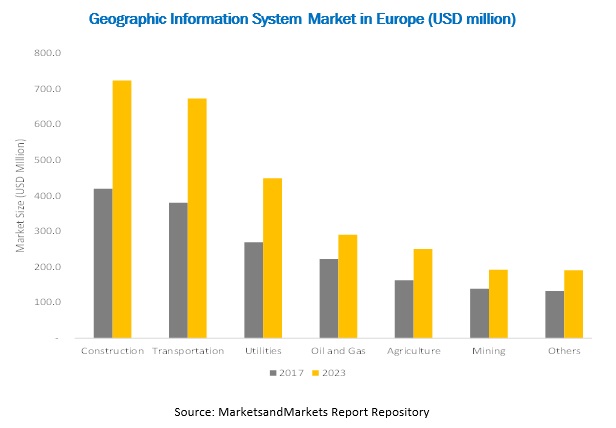MarketsandMarkets has identified some of the
important industries in Europe where GIS expected to have significant
impact for 2017 and beyond. These have been classified into agriculture,
oil and gas, construction, transportation, utilities, mining, and
others. The geographic information system (GIS) market in Europe is projected to reach USD 2.77 billion
by 2023, at a CAGR of 8.2% between 2017 and 2023.
Convergence and integration of geospatial technology
with mainstream technologies such as analytical tools, database, &
enterprise solutions (e.g., ERP and CRM) are considered one of the key
drivers expanding the utility of geospatial analytics across various
industries. Geospatial data collected from various sources are stored,
processed, and analyzed to derive geographic information. The
geospatial analyzed information is used for decision-making by various
end users. The adoption of geospatial technology has further resulted
in improved productivity and efficiency of enterprises across different
sectors such as transportation, energy, mining, oil & gas,
telecommunication, construction, agriculture, and business enterprises.
For instance, real estate site selection, route selection, zoning,
planning, conservation, and natural resource extraction involve the
usage of geospatial analytics and geographic information system (GIS)
solutions. Geospatial software and service providers can deploy more
comprehensive solutions through technology convergence and integration
with mainstream technologies.
Convergence and integration of
geospatial technology with mainstream technologies such as analytical
tools, database, & enterprise solutions (e.g., ERP and CRM) are
considered one of the key drivers expanding the utility of geospatial
analytics across various industries. Geospatial data collected from
various sources are stored, processed, and analyzed to derive geographic
information. The geospatial analyzed information is used for
decision-making by various end users. The adoption of geospatial
technology has further resulted in improved productivity and efficiency
of enterprises across different sectors such as transportation, energy,
mining, oil & gas, telecommunication, construction, agriculture, and
business enterprises. For instance, real estate site selection, route
selection, zoning, planning, conservation, and natural resource
extraction involve the usage of geospatial analytics and geographic
information system (GIS) solutions. Geospatial software and service
providers can deploy more comprehensive solutions through technology
convergence and integration with mainstream technologies.

To know about the assumptions considered for the study download the pdf brochure
Role of GIS in Agriculture
GIS is used in the survey of plantation crops and
management of fertilizers, pesticides, and insecticides. GIS is an
essential tool for mapping and managing agricultural resources as it
provides analytics and assists users in decision-making for crop
planning and land-resource management. GIS plays a crucial role in
agriculture by increasing yields, managing agricultural resources,
predicting outcomes of yield, and improving farm practices. Agricultural
land mapping plays a vital role in the management of land resources.
High-resolution geospatial images collected from remote sensing and land
surveying are used to map and analyze soil data to improve farming
methods and procedures. The use of GIS helps farmers to manage their
land resources efficiently. In addition, GIS technologies offer
agricultural land cover mapping and assessment of crop damage caused by
natural disasters.
Significance of GIS in Oil & Gas
Geographic information system plays an important role
in the oil & gas industry. Crude oil and gas are now found in
deeper layers of the earth’s crust than before, and hence it is
essential to use precise technologies such as GIS for oil and gas
exploration as well as for its appropriate utilization. In oil &
gas, GIS technologies such as satellite imagery and airborne remote
sensing are widely used for oil and gas exploration, drilling oil wells,
and pipeline management. GIS provides insight on the selection of areas
for an exploration drilling process. Exploration drilling and pipeline
management require accurate geographical data mapping. In addition, GIS
provides assistance in locating new oil and gas resources and manage its
extraction and supply.
GIS helps in engineering and designing of construction projects
Construction end user is a leading adopter of
geospatial technologies. GIS plays an important role in mapping and
surveying of construction sites and serves as a complete platform for
infrastructure development life cycle. Urban planning and infrastructure
development require accurate mapping and surveying of the geographic
area. GIS can accurately assess construction projects such as a dam,
bridge, sewer, canal, industrial park, water management, and power
plant. GIS tools are integrated with computer-aided design (CAD) tools
for civil engineering applications. The increasing urbanization and
growing population have created an urge for the use of GIS for
systematic and synchronized planning of land and other resources. Some
of the important applications of GIS in construction are land surveying,
building information modeling (BIM), land cover mapping, property
assessment, urban planning, and smart city planning.
Role of GIS in transportation planning
GIS is gaining traction in transportation
applications such as transportation planning, highway maintenance,
traffic modeling, accident analysis, and route planning. GIS helps
transportation planners to store and analyze geospatial data as well as
mapping of transportation features with a base map. GIS plays a
significant role in highway infrastructure management and development of
roads, bridges, and railway routes. With the increase in urbanization,
there is a need for effective transportation planning. GIS tool can be
used in managing, planning and evaluating transportation management
systems. Integration of transportation information system (TIS) with GIS
is commonly referred to as GIS for transportation (GIS-T). With the
growing adoption of GIS in transportation, companies are focusing on
developing transportation-specific GIS applications. For instance,
Caliper Corporation (US) offers TransCAD, GIS software, specially
designed for transportation applications such as traffic modeling and
transportation planning.
Mr. Shelly Singh
MarketsandMarkets™ INC.
630 Dundee Road
Suite 430
Northbrook, IL 60062
USA : 1-888-600-6441
No comments:
Post a Comment